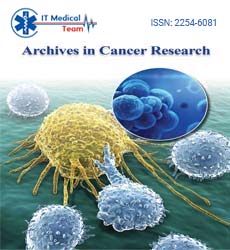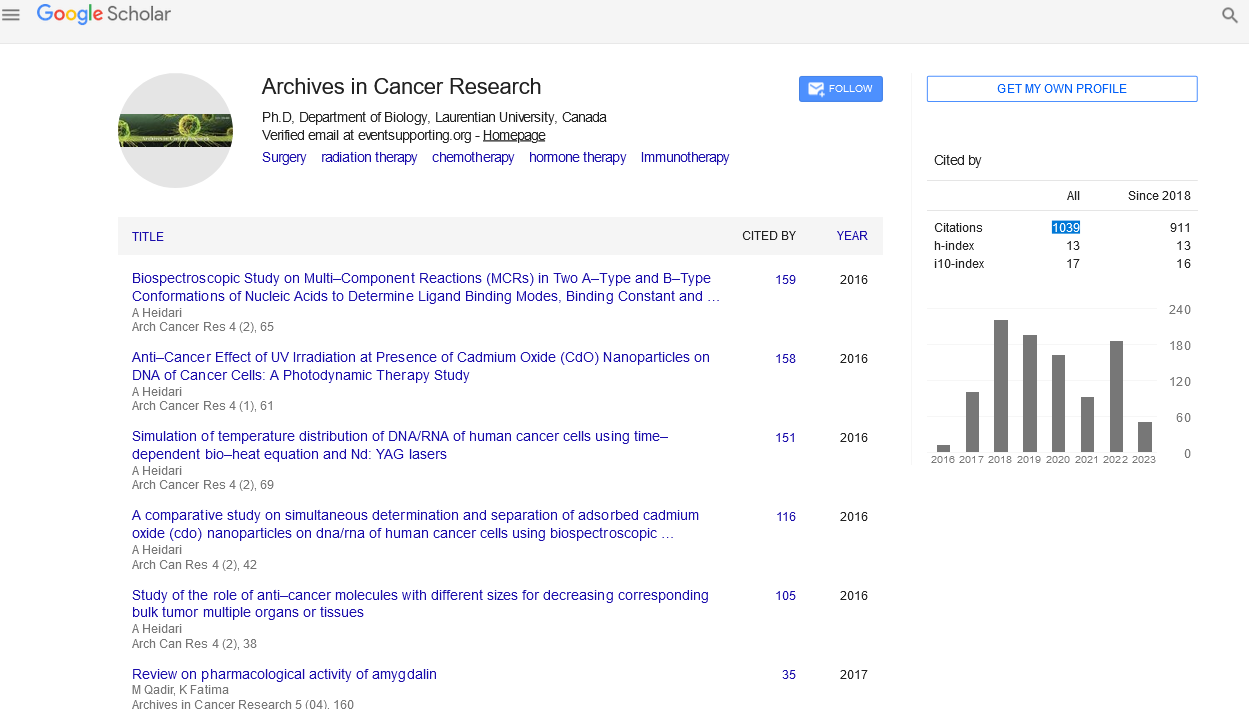Mini Review - (2023) Volume 11, Issue 4
Renal Cell Cancer
Lockwood Jonathan*
1International Epidemiology Institute, USA
*Correspondence:
Lockwood Jonathan, International Epidemiology Institute,
USA,
Email:
Received: 01-Jul-2023, Manuscript No. ipacr-23-13721;
Editor assigned: 03-Jul-2023, Pre QC No. P-13721;
Reviewed: 17-Jul-2023, QC No. Q-13721;
Revised: 22-Jul-2023, Manuscript No. R-13721;
Published:
28-Jul-2023
Abstract
Malignant (cancer) cells are located in the lining of kidney tubules, which are incredibly tiny tubes. This condition is known as renal cell cancer, kidney cancer, or renal cell adenocarcinoma. On either side of the spine, above the waist, are two kidneys, one on each side. Blood is filtered and cleaned by tiny kidney tubules. Urine is created by removing waste. One lengthy tube called a ureter connects each kidney to the bladder, where the urine is excreted. Up until the urethra allows it to exit the body, the bladder stores the pee
Keywords
Malignant cancer; Renal cell cancer; Kidney tubules
INTRODUCTION
One of the three prevalent tumours of the urinary system,
kidney cancer is believed to impact more than 400 000
individuals a year, with 40% of these patients dying from
the disease. The clear cell renal cell carcinoma (ccRCC) is the
type of cell that occurs most frequently in clinical settings.
Even with this well-known disease kind, practitioners could
have difficulty in selecting an appropriate course of action
because they are only given the patient's clinical data and
do not know their precise prognosis. In order to support
clinical practise, efforts have also been undertaken to build a
reliable prognostic model. Self-renewal and differentiation
potentials, which are specialised cell capabilities of stem
cells, are referred to as stemness. Intriguingly, it has been
shown that cancer cells increasingly acquire stem cell-like
characteristics as they advance, aiding in their expansion
and metastasis. A new parameter deserving of note was
created as a result of machine learning algorithm-assisted
analyses of this dedifferentiated oncogenic state. This
parameter is known as stemness indices, and it has been
demonstrated that it can both identify the phenotype of
cancer cells and correlate with the prognostics of various
cancer types [1-5].
Renal cell carcinoma (RCC), which includes a variety of
cancers, is the most prevalent pathological subtype of kidney
cancer. 11 histologic forms of RCC, including clear cell,
chromophobe, oncocytoma, and papillary of two kinds,
were recognised by the World Health Organisation (WHO)
in 2004. The most prevalent and dangerous form of RCC
is clear cell renal cell carcinoma (ccRCC). Furthermore, a
third of patients with ccRCC who have locally progressed
or distant spread are classified as late-stage tumour patients,
which has a very bad prognosis. Additionally, conventional
therapies are ineffective since individuals with ccRCC are
not responsive to both chemotherapy and radiotherapy,
while immunotherapy, such as immune checkpoint
inhibitors (ICIs), which target CTLA-4, PD-1/PD-L1, has
been shown to be extremely effective. Genomic instability
(GI), which arises from mutations in DNA repair genes
and consequently encourages tumour development and
metastasis as well as resistance to various treatments, is a
notable hallmark of cancer. Evidence is mounting that links
genetic instability to the clinical outcomes of individuals
with different malignancies.
Non-coding RNAs (ncRNAs), sometimes known as RNA
transcripts without the ability to code for proteins, including
long non-coding RNAs (lncRNAs). The ncRNAs are
classified as long ncRNAs (lncRNAs) if the cut-off value of
the length is greater than 200 nucleotides; otherwise, they
are found to be tiny ncRNAs. New research suggests that ncRNAs are essential for DNA repair and genomic integrity,
which is vital for tumour cell survival and carcinogenesis
prevention. According to Mathias et al., NORAD, a highly
conserved lncRNA that is a crucial component of the
topoisomerase complex NARC, is crucial for preserving
genomic integrity. Additionally, NORAD is raised as
a result of DNA damage, which causes chromosomal
instability. By knocking off the lncRNA GUARDIN,
which is closely associated to the p53 response, tumour
development is inhibited and the cytotoxicity brought
on by extra stress is increased. GUARDIN is crucial for
preserving genomic integrity and may aid in the creation
of tailored therapies. Despite the foregoing discoveries, the
clinical importance and prognostic usefulness of lncRNAs
associated to genomic instability remain unknown.
Around 2% of malignancies in the globe are renal cell
cancers. North America and northern Europe have seen an
increase in its prevalence, while other parts of the world
have not. The greatest rates are now observed among black
people in the United States, where the pace of rise has
been roughly 3% every year. The 5-year relative survival
rate increased from 30% to 40% in the 1960s to between
50% and 60% in the 1990s, indicating that survival has
improved. Numerous epidemiologic research, in particular
case-control studies, have looked for etiological hints. The
development of renal cell carcinoma is a direct result of
cigarette smoking. Obesity or having a high relative body
weight has been cited in nearly every study as another
important factor, particularly for women. Although the
cause is uncertain, high blood pressure or its treatments
may potentially be involved. It has been suggested that
some occupational exposures, such as asbestos, coke oven
emissions, petrol and solvents, increase the risk of certain
diseases; however there is no solid evidence to support this
claim or that of any other occupational hazard. One of the
few consistently observed dietary findings is the inverse
relationship between risk and intake of fruits and vegetables,
which has been shown in a number of studies. It is doubtful
that there is a connection between renal cell carcinoma
and coffee, alcohol, or any other beverage. A considerable
fraction of cases include genetic predisposition, perhaps
through a variety of pathways. Future etiologic research
should concentrate on the ways in which obesity raises risk,
the impact of high blood pressure and its treatments, and
the causes of the startlingly quick rise in incidence among
Americans of African descent.
Although sporadic, 2% to 4% of RCCs are familial in origin.
Hereditary papillary renal cancer (HPRCC), hereditary
leiomyomatosis RCC, Birt-Hogg-Dube (BHD) syndrome,
chromosome 3 translocation, and tuberous sclerosis (TCS1,
TCS2) are among the genetic disorders linked to RCC. A
dominantly inherited multisystemic condition called VHL syndrome causes tumours in a number of different organs,
including the kidneys (sometimes multiple, bilateral
tumours), pancreas, adrenal glands, epididymis, eyes, spine,
and cerebellum. Renal cell carcinoma is the most prevalent
cause of mortality and the cumulative chance of developing
it by the age of 60 is greater than 70%. The VHL tumorsuppressor
gene, which is located on chromosome 3p, is
implicated in both spontaneous and hereditary RCC and is
inactivated by a number of processes, including mutation
and silencing by DNA methylation. Only the conventional
(clear cell) cancer is caused by this gene. At least 50% of
sporadic clear cells RCC are caused by somatic mutations
in the VHL gene, while another 10% to 20% are caused
by gene methylation. Increased production of angiogenetic
factors such vascular endothelial growth factor is correlated
with loss of VHL gene function. In vascularized tumours
like RCC, overexpression of endothelial growth factor
may favour development and progression. Through
hypoxia-inducible factor (HIF), the VHL tumour
suppressor protein (pVHL) also plays a significant part in
the mammalian oxygen-sensing system. HIF causes the
production of a number of genes that are involved in the
control of angiogenesis, cell growth, or cell survival when
pVHL is absent [6-10].
CONCLUSION
New sensitive imaging methods may have unintentionally
discovered slow-growing, non-lethal tumours, increasing
the likelihood of localised disease progression and
contributing to the rising prevalence of RCC in most
populations. However, the rising prevalence encompasses
both smaller local tumours and more advanced tumours,
which explains why certain nations still have high death
rates. The recent levelling of RCC mortality in the United
States and many European nations is probably due to the
rising prevalence of early RCC diagnosis in many nations.
Nevertheless, across all phases, about 50% of patients pass
away within 5 years of their diagnosis. In high-risk nations,
obesity and cigarette smoking may be responsible for 40%
of all incidental cases. In addition to obesity, increased
rates of hypertension might possibly be a factor. The risk
of RCC may also be impacted by a number of additional
lifestyle and occupational variables. According to a World
Cancer Research Fund and American Institute for Cancer
Research expert panel, there are a number of leads about
dietary components, but no relationship has been regarded
as causative. The disparity between populations may also be
influenced by genetic differences. Better treatment options
are required, as well as ongoing study into the aetiology
of RCC. The ongoing investigation of environmental
issues should consider RCC while looking for preventive
measures.
REFERENCES
- Weber KL, Randall RL, Grossman S, et al. Management of lower-extremity bone metastasis. J Bone Joint Surg Am. 2006; 88(4): 11-19.
Indexed at, Google Scholar, Crossref
- Ruggieri P, Mavrogenis AF, Casadei R, et al. Protocol of surgical treatment of long bone pathological fractures. Injury. 2010; 41(6): 1161-1167.
Indexed at, Google Scholar, Crossref
- Harrington KD, Sim F, Enis J, et al. Methylmethacrylate as an adjunct in internal fixation of pathological fractures. Experience with three hundred and seventy-five cases. J Bone Joint Surgery. 1976; 58(9): 1047-1055.
Indexed at, Google Scholar
- Kumar S, Kashyap P. Antiproliferative activity and nitric oxide production of amrthanolic extract of Fraxicus micrantha on michigan cancer foundation-7 mammalian breast cancinoma cell line. J Intercult Ethnopharmacol. 2015; 4(8): 109-113.
Indexed at, Google Scholar, Crossref
- Coleman RE, Lipton A, Roodman GD, et al. Metastasis and bone loss: advancing treatment and prevention. Cancer Treat Rev. 2010; 36(9): 615-620.
Indexed at, Google Scholar, Crossref
- Adler RA, Gill RS. Clinical utility of denosumab for treatment of bone loss in men and women. Clin Interv Aging. 2011; 6(6): 119-124.
Indexed at, Google Scholar, Crossref
- Kachnic LA, Pugh SL, Tai P, et al. RTOG 0518: Randomized Phase III Trial to Evaluate Zoledronic Acid for Prevention of Osteoporosis and Associated Fractures in Prostate Cancer Patients. Prostate Cancer Prostatic Dis. 2013; 16(2): 1-10.
Indexed at, Google Scholar, Crossref
- Oboma YI, Susan BE, Elesha SO, et al. Breast cancer biomarkers at Niger delta University hospital: Comparisons with national and International trends and clinical significance. J Patphy. 2017; 903(7): 1-6.
Indexed at, Google Scholar, Crossref
- Ruggieri P, Mavrogenis AF, Casadei R, et al. Protocol of surgical treatment of long bone pathological fractures. Injury. 2010; 41(6): 1161-1167.
Indexed at, Google Scholar, Crossref
- Selvaggi G, Scagliotti GV. Management of bone metastases in cancer: a review. Critical reviews in oncol hematol. 2005; 56(8): 365-378.
Indexed at, Google Scholar, Crossref





